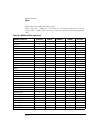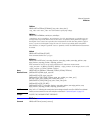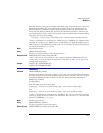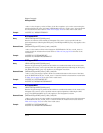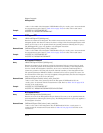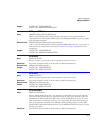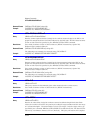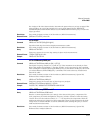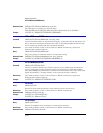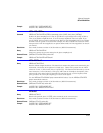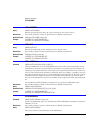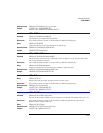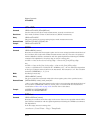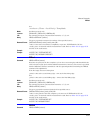
18-20
Measure Commands
JITTer:DDJVsbit:EARLiest?
Returned Format [:MEASure:JITTer:DDJVsbit] <value><NL>
Example 10 OUTPUT 707;”:SYSTEM:HEADER OFF”
20 OUTPUT 707;”:MEASure:JITTer:DDJVsbit?”
JITTer:DDJVsbit:EARLiest?
Query :MEASure:JITTer:DDJVsbit:EARLiest?
Returns comma-separated values (string) for the earliest measured edge in the DDJ vs. bit
graph. The string includes the bit number followed by the DDJ value. The DDJ value has units
of time or unit interval as specified by the :MEASure:JITTer:UNITs command.
Restrictions Jitter mode. Software revision A.04.20 and above (86100C instruments). Option 200,
Enhanced Jitter Analysis Software.
Returned Format [:MEASure:JITTer:DDJVsbit:EARLiest] <string><NL>
The following is an example of a returned string: “30, 3.4339e-12”
Example 10 OUTPUT 707;”:MEASURE:JITTER:DDJVSBIT:EARLIEST?”
JITTer:DDJVsbit:LATest?
Query :MEASure:JITTer:DDJVsbit:LATest?
Returns comma-separated values (string) for the latest measured edge in the DDJ vs. bit
graph. The string includes the bit number followed by the DDJ value. The DDJ value has units
of time or unit interval as specified by the :MEASure:JITTer:UNITs command.
Restrictions Jitter mode. Software revision A.04.20 and above (86100C instruments). Option 200,
Enhanced Jitter Analysis Software.
Returned Format [:MEASure:JITTer:DDJVsbit:LATest] <string><NL>
The following is an example of a returned string: “30, 3.4339e-12”
Example 10 OUTPUT 707;”:MEASURE:JITTER:DDJVSBIT:LATEST?”
JITTer:DJ?
Query :MEASure:JITTer:DJ?
This query returns the deterministic jitter value measured on the current source.
Restrictions Jitter mode. Software revision A.04.00 and above (86100C instruments).
Returned Format [:MEASure:JITTer:DJ] <value><NL>
Example 10 OUTPUT 707;”:SYSTEM:HEADER OFF”
20 OUTPUT 707;”:MEASure:JITTer:DJ?”
JITTer:EBITs?
Query :MEASure:JITTer:EBITs?
Returns an ordered list of edge bit numbers returned as definite-length block data. Each
value is the number of the bit in the pattern preceding the edge transition and is in the range
of 0 to PatternLength-1. Each bit number is a four byte integer. Only the edges of the type
specified by the command :MEASure:JITTer:EDGE are included in the list. The data block is
followed by a terminator character, 0A hex (linefeed). This query will return an incomplete



